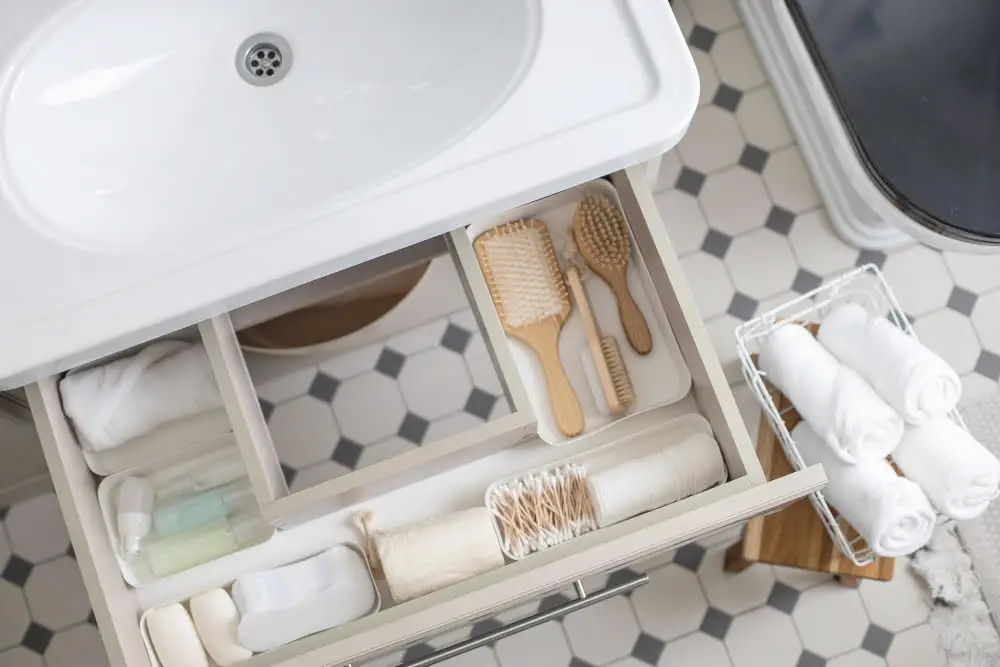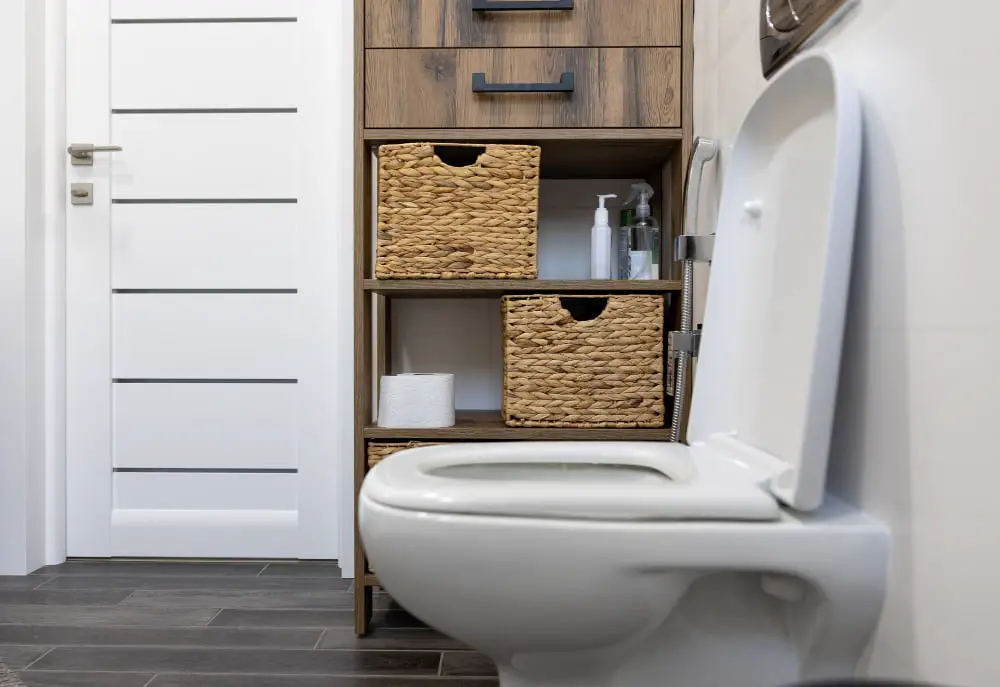Last updated on
Discover practical and effective strategies to declutter your bathroom, transforming it into a serene, organized space.
Overflowing drawers, crowded countertops, and a disarray of toiletries can turn a bathroom into a chaotic mess. A well-organized bathroom, on the other hand, can be a sanctuary where you prepare for the day ahead or unwind from the one that’s passed.
This article will guide you through the process of decluttering your bathroom efficiently, transforming it into a tidy, stress-free zone.
From sorting out your skincare products to optimizing storage space, every aspect will be covered in detail, providing you with a comprehensive solution to your bathroom clutter woes.
Key takeaways:
- Understanding bathroom clutter is the first step.
- Decluttering fosters efficiency, peace of mind, and a healthier environment.
- Start by removing all items and categorizing them into essentials and non-essentials.
- Allocate enough time, gather supplies, and plan your organization strategies.
- Ask essential questions to help identify what is necessary and what is not.
Table of Contents
Understanding Bathroom Clutter

Clutter in the bathroom can accumulate rapidly. With limited space and an array of products—ranging from toiletries to towels—it’s easy for things to get out of hand.
It’s often due to a lack of proper organization rather than a surplus of items. A blend of forgotten purchases, expired products, duplicate items, and items you simply don’t need or use contribute to this clutter.
Recognizing and understanding these underlying issues is the first step towards achieving and maintaining a clutter-free bathroom.
Importance of Decluttering

An orderly bathroom fosters efficiency and peace of mind. By eradicating clutter, you spend less time hunting for items and more time on self-care rituals.
Additionally, maintaining a neat bathroom can significantly reduce stress levels, creating a peaceful start and end to your day.
Furthermore, decluttering makes cleaning easier, contributing to a healthier, more hygienic environment.
Lastly, a decluttered bathroom is more inviting – every shower, bath, or quick touch up becomes a pleasure in a beautifully organized space.
Starting a Bathroom Declutter

Before initiating the process, ensure that you have necessary cleaning supplies, trash bags, and containers for sorting items. Begin with removing all items from drawers, cabinets, shower shelves, and other storage spaces.
Categorize these items into essentials and non-essentials. Items such as expired products, empty shampoo bottles, and seldom-used accessories fall in the non-essential category.
Clearing out these items provides you with an accurate picture of what needs organization, what can be kept for use, and what requires disposal. Having this foundation will make the decluttering process smoother and more efficient.
Starting With a Solid Plan

First and foremost, you need to allocate enough time for this task. You don’t want to rush and risk overlooking crucial areas or items.
Next, gather cleaning supplies, bags for waste and recycling, and containers for categorization purposes. Having these items on hand in advance saves time and maintains momentum during the process.
It’s also advisable to consider the inventory of your bathroom content – decide on the necessity of each item. Categorize them by type, frequency of use, and size to help determine their place later.
Lastly, keep a mental or written note of bathroom spaces that seem to accumulate the most clutter. These areas will need special attention when implementing new organization strategies.
Essential Questions for Bathroom Decluttering

Before embarking on your decluttering journey, it’s essential to obtain a clear understanding of what you use and what you don’t. The key is to be ruthlessly honest with yourself.
Here are some crucial questions to aid the sorting process:
- Do you regularly use the item?
- How often do you use it – daily, weekly, or rarely?
- Is the product expired, and if so, is it safe to use?
- Does it bring value to your daily routine, or just sit unused?
- Are there duplicates of the same item?
These inquiries will help identify what is essential and what is not, making the decluttering task easier and worthwhile.
Identifying Unnecessary Items in the Bathroom

Begin by scrutinizing every item in your bathroom. Look out for expired products first – they are easy to discard and pose health risks if accidentally used.
After dealing with expired items, turn attention to duplicates. Keep one as a backup and consider giving away the others, or get rid of them if they’re not being used.
Also, toss any product that you have not used in several months.
Remember, it’s not just about products. Decorations, bath mats, or any other items that you seldom use should be considered for removal.
By focusing on items usage and necessity, you can easily spot clutter and reduce the amount of stuff in your bathroom.
Sorting Out Essentials

Identify which items you use on a daily basis. From toothpaste and face wash to towels and makeup essentials, these need to be easily accessible.
Aim to keep the number of items on your countertops as minimal as possible for optimal functionality and aesthetics.
Pare down to essential tools and frequently used products, storing the latter in a designated area.
Remember, less is more when creating an uncluttered space.
Prioritizing Daily-use Products

Begin by distinguishing the products you use every day from those used occasionally.
These essentials – from your toothbrush and toothpaste to your favorite skincare items – should be easily accessible.
Consider dedicating a specific space for these items, like a drawer or a container on the countertop.
This way, you’ll avoid rummaging through piles of products each morning and evening, saving you valuable time and maintaining the neatness of your bathroom.
Ensure that these daily essentials are returned to their designated area after each use to preserve the order you’ve created.
Disposing of Unnecessary Items

In order to create a clean and clutter-free bathroom, it’s crucial to take a hard look at the items that are no longer required or beneficial.
Start by discarding expired or seldom-used cosmetics, medications, and personal care products, as they not only take up a lot of space but can also become less effective or potentially harmful after their expiration date.
Products that didn’t live up to your expectations or cause skin irritation should be set aside for disposal as well. They do not serve any purpose other than crowding your bathroom and creating confusion.
Seek to reduce duplication by keeping only your favorite version of products that serve a similar purpose, like body lotions or shampoos.
Lasty, consider donating unopened, unused items especially travel size toiletries that you don’t see yourself using. Many shelters or charity organizations would gladly appreciate these contributions.
Remember, the key to a successful decluttering process is to be ruthless when deciding what to keep and what to dispose of. Keep your focus on creating a neat, organized, and functional space that serves your needs effectively.
Maintaining Toilet Area Hygiene

Consider using a basket or bin to neatly store spare toilet paper rolls, refills for air fresheners, and cleaning products like brushes and sanitizing wipes.
For personal items like feminine hygiene products, keep them discreetly stored in decorative containers within easy reach.
Ensure you clean the area regularly using effective, non-toxic cleaners — wiping down surfaces, knobs, handles, and the toilet seat.
Regular maintenance will make the space not only clean and fresh but also hygienic, reducing the risk of spreading germs and illnesses.
Another useful tip is to keep a small waste bin, with a lid for discretion, for disposing of non-flushable items to further enhance the cleanliness of the area.
Remember, a clean and organized toilet area is crucial for a decluttered and hygienic bathroom.
Tackling the Shower Area

Begin with the shower caddy, examining each item you find. If it hasn’t been used in over a month, remove it. Group similar items together such as shampoos, conditioners, and body washes.
If you have multiple half-empty bottles, consider consolidating them.
Next, address any built-in soap dishes or corner shelves. These spots often attract clutter, such as razors or bars of soap. Store only the most frequently used items here. Baskets or suction cup containers on the shower wall can provide additional storage without making the area feel packed.
Once you’ve sorted through all items, give the shower or tub a thorough clean. Not only does this provide a fresh start, but the renewed sparkle may motivate you to keep your pared-down collection of items tidy. Don’t forget to address the shower curtain or door as well.
Finally, establish a routine for reviewing shower items. This can ensure that the area remains well-organized, creating a ripple effect throughout your entire bathroom.
Cleaning Up the Countertops

By arranging items aesthetically and intelligently, you can maintain clean and visually pleasing countertops. Use a tray or basket to contain frequently used products, such as lotions, all in one place, making them easy to access.
To minimize visual clutter, ensure only daily essentials are displayed, while less frequently used items are tucked away in drawers or cabinets. Small storage solutions, like a toothbrush holder or soap dish, can prevent loose items from cluttering up the space.
Consider installing floating shelves or a storage rack for additional space to house items without cramming the countertops. Investing in items with dual functionality, like a mirror with an attached shelf, can further optimize your counter space management.
With regular maintenance, clear and organized countertops can serve as a calming factor in an often-frenzied space.
Organizing Your Vanity

Most bathrooms feature a vanity which often becomes a hodgepodge of various items. To combat this clutter, start with a thorough cleanse. Remove everything and wipe the space clean.
Then, sort products based on frequency of use. Daily essentials like toothpaste and cleanser should be easily accessible, while rarely used items can be stowed away.
For makeup and grooming tools, consider using drawer dividers or small storage containers. This will prevent items from moving around and becoming disorganized.
Those with larger vanities can take advantage of vertical space by implementing stackable storage or tiered organizers.
Next, tackle those often ominous under-sink cabinets. These are great spots for storing bulk items, cleaning supplies, or extra towels.
Again, using organizational tools like bins or baskets can maintain order and visual appeal.
- Staying on top of vanity clutter is crucial.
- Make it a habit to regularly clear out expired products, and get rid of items that are no longer being used.
This way, your vanity remains a pleasure to use, not a chore to confront.
Drawer Organization Strategies
Begin with emptying the drawers completely, separating items into categories as you go. Once emptied, wipe down the interiors to create a clean slate.
After this, analyze the emptied contents, discarding any expired products, duplicates, or those not used in the past six months.
Next, use drawer dividers or small containers to group similar items together. For example, keep dental care products in one section, makeup in another, and so forth.
Drawer liners can also be used to prevent items from sliding around every time you open or close the drawer.
Establish an easy-to-follow system where regularly used items are at the front for quick access, while less frequently used items go towards the back. This way, it is less likely that things become jumbled over time.
Finally, once the drawers are neatly arranged, instill a habit of putting things back in their designated spaces immediately after use. This step is crucial in maintaining a long-term organized state of your drawers.
Minimizing Clutter in Bathroom Drawers
Begin with an empty drawer. Before refilling, clean it thoroughly to remove any dust or residue.
After, group items by category such as dental care, make-up, or hair accessories.
Consider utilizing drawer organizers or diver compartments to maintain nice and neat storage sections.
Smaller items such as floss or hair ties can be stored in reusable containers or small baskets.
Place frequently used items in the most accessible areas of the drawer.
Regularly, perhaps monthly, revisit your drawers to reorganize and dispose of any items that have crept in and are not needed.
That way, you ensure your bathroom drawers remain user-friendly and clutter-free.
Implementing Storage Solutions
Consider installing floating shelves or stacked baskets to utilize vertical space effectively. They can house your towels, toiletries, and decorative elements without taking up too much room.
Utilize the space inside your cabinet doors by mounting adhesive pockets or small racks. Remember, clear containers make items easily visible and can streamline the appearance of your bathroom.
For greater efficiency, segregate your items according to their usage. A lazy Susan in your bathroom cabinet can work wonders for small items like nail clippers, floss, and tweezers.
Over-the-door organizers and slim rolling carts can provide additional room for storage without occupying much floor space.
Linen Cabinet Optimization
Maximize your cabinet’s square footage by starting with a clean canvas; empty it completely.
Avoid stacking towels and linens too high. Create neat, low stacks or roll them for easy access.
For a lighter visual impression, consider keeping the heaviest items at the bottom.
Use shelf dividers to prevent piles from toppling over and to create additional levels within each shelf.
Baskets can do wonders for corraling smaller items such as washcloths or toiletries, creating a cleaner presentation.
For infrequently used items like spare toothbrushes, dental floss, or sample-sized products, consider using clear containers stored out of sight, but still easily reachable when needed.
These strategies help reduce clutter while increasing overall functionality. Importantly, an organized cabinet ensures less time wasted searching for items, particularly on busy mornings.
Creative Space Utilization
Consider the unused spaces that are often overlooked – the inside of the cabinet doors, the wall space above the toilet, even the ceiling can be used for hanging baskets.
Use shower caddies on the inside of your under-sink cabinets to store cleaning supplies.
Magnetic strips can hold bobby pins or tweezers.
Installing a shelf above the doorway can serve as a great place to store towels.
Vertical storage solutions like multi-tier corner shelves or over-the-door organizers can offer additional storage space without cluttering your floor area.
These clever hacks not only provide extra room but also keep items conveniently at hand.
Each fixture or piece of furniture can provide a storage opportunity if you think creatively.
Long-term Decluttering Strategies
Establishing a system is key to maintaining a clutter-free bathroom. Dedicate a few minutes each day to put things back where they belong.
Consciously resist the urge to overbuy and hoard products. Aim for fewer, higher quality items that you really need and regularly use.
Embrace the principle of ‘one in, one out.’ Whenever you bring a new item, ensure to discard or donate an old one.
Regularly inspect items for expiration dates and get rid of old or unused products every few months.
Not only does this keep your bathroom organized, but it also contributes to better health and hygiene.
Lastly, make decluttering and organizing a part of your cleaning routine; this will help you maintain an orderly and serene bathroom space.
Implementing Finishing Touches for a Neat Bathroom
Begin with broadly categorizing items into ‘daily use’ and ‘occasional use’ and storing them accordingly. Consider adding labels to storage containers for quick identification. Implement small finishing touches like installing hooks on doors for hanging robes or towels, using drawer dividers for ease of access, and investing in a shower caddy for all your shower essentials.
Utilize vertical space if the bathroom is small, with floating shelves or over-the-door organizers. Keep frequently used items within easy reach and less often used ones on higher or hidden shelves. Finally, ensure all surfaces are clean and uncluttered, making your bathroom look visually pleasing and tranquil.
Consistently keep an eye out for any clutter build-up, attend to it promptly – remember, a little effort every day keeps the mess at bay. A decluttered bathroom reflects a decluttered mind and helps to maintain an overall positive living environment.
FAQ
What room should you declutter first?
The optimal room to begin decluttering efforts should be the one where you spend the majority of your time.
What is the most efficient way to declutter a bathroom?
The most efficient way to declutter a bathroom is by categorizing and separating items, disposing of expired or unused products, using storage solutions effectively, and maintaining regular cleaning schedules.
What essential items should one keep after bathroom decluttering?
Key items to preserve after bathroom decluttering are toilet paper, hand and bath towels, necessary toiletries, a first aid kit, necessary medication, and bathroom cleaning supplies.
How can decluttering positively impact one’s mental health in connection with bathroom organization?
Decluttering and organizing the bathroom can positively impact mental health by reducing stress and anxiety, promoting relaxation, and enhancing productivity and focus by creating a clean, functional, and aesthetic space.




